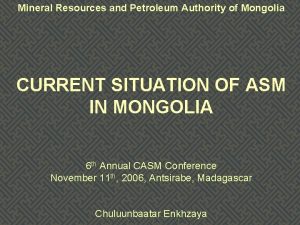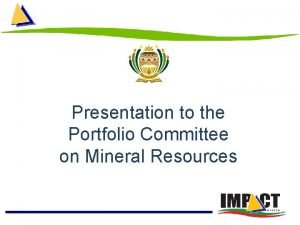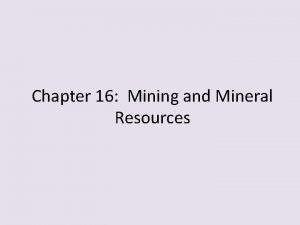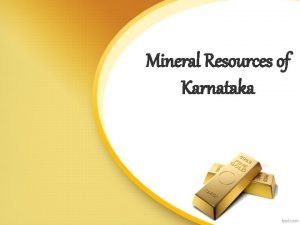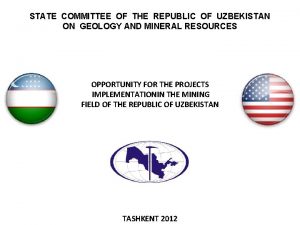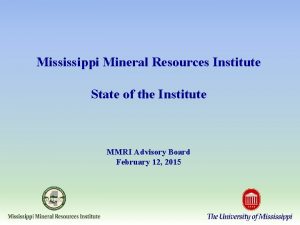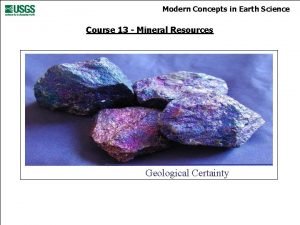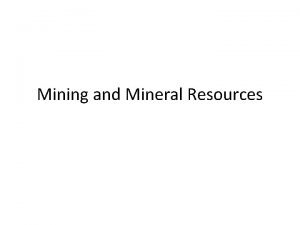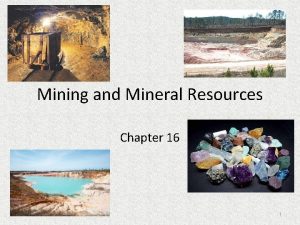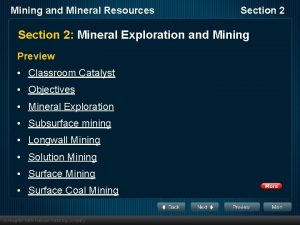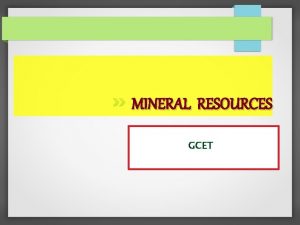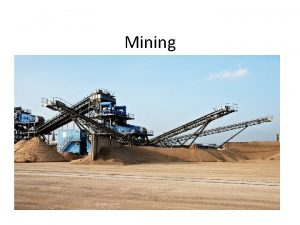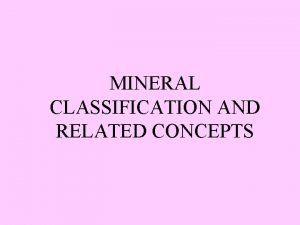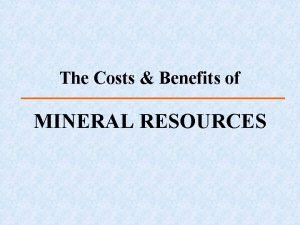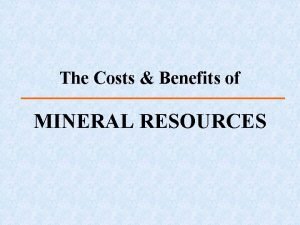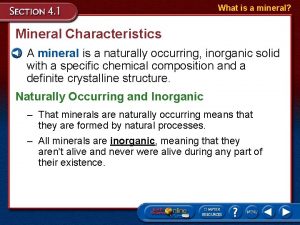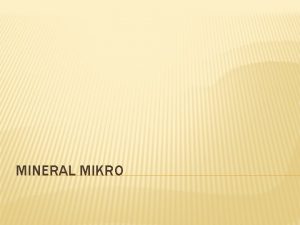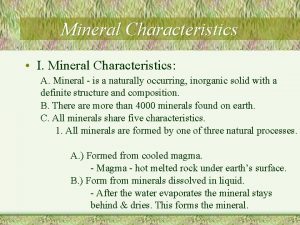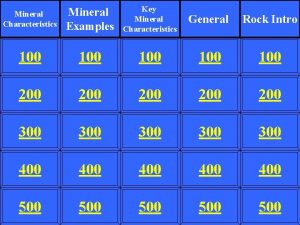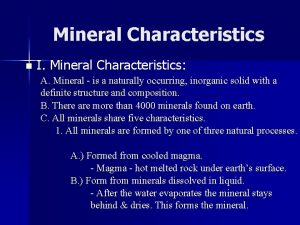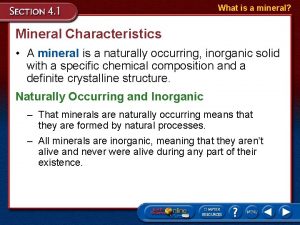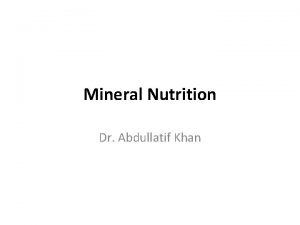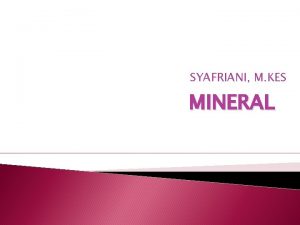CHAPTER 13 Mineral Resources and Mining Mining for





















- Slides: 21

CHAPTER 13 Mineral Resources and Mining

Mining for. . . Cell Phones? • Large reserves of the metal tantalum are found in the Democratic Republic of the Congo, in Africa. • Tantalum jumped in value in the 1990 s as high-tech devices that need tantalum, such as cell phones, became common. • There is international concern regarding the role tantalum mining has played in the extended conflict in the Congo. Talk About It Is it important to think about the sources of the minerals we use?

Lesson 13. 1 Minerals and Rocks Amethyst Over 4000 minerals have been identified, but only 1% of these are common in Earth’s crust.

Lesson 13. 1 Minerals and Rocks What Are Minerals? • Occur in nature • Chemically inorganic • Solids • Have orderly crystalline structures • Have definite chemical compositions Pyrite (Fool’s Gold)

Lesson 13. 1 Minerals and Rocks Properties of Minerals Property • Color • Streak • Luster • Crystal • Hardness • Cleavage • Fracture • Density Description A few minerals can be identified by their color. But color varies in most minerals depending on how they form. The streak of a mineral is the color of its powder. Although mineral color may vary, streak color does not. How light is reflected off a mineral’s surface is called luster. It may be described as glassy, earthy, silky, metallic, etc. A mineral can be identified by the particular arrangement of its atoms. Mohs scale ranks mineral hardness 1– 10. 1 = talc, which can be scratched by a fingernail. 10 = diamond, which can scratch all known common minerals. A mineral that splits easily along a flat surface and forms a new “face” is said to have cleavage. Minerals that break irregularly, rather than leaving a flat surface, have fracture, not cleavage. Each mineral has a characteristic density—mass per unit volume.

Lesson 13. 1 Minerals and Rocks Mineral Formation • Minerals can form in four ways: • Crystallization from magma or lava • Precipitation • Pressure and temperature • Production by organisms Salt basins of the Sierra Nevada The Miwok people filled these basins with water from a salt spring and let it evaporate, to form salt for trading. Coral Mineral formed by living things

Lesson 13. 1 Minerals and Rocks Mineral Classes • Minerals are classified based on their elements or compounds.

Lesson 13. 1 Minerals and Rocks • Naturally occurring solids made up of minerals and mineral-like materials • Three types: igneous, sedimentary, metamorphic • The rock cycle slowly changes rocks from one type to another through heating, melting, cooling, weathering, and erosion.

Lesson 13. 1 Minerals and Rocks Types of Rocks • Igneous: Form when magma cools and solidifies; can be intrusive or extrusive • Sedimentary: Form when sediments cement together or when water evaporates and leaves behind minerals; can be clastic, chemical, or biochemical • Metamorphic: Form when heat or pressure changes the crystalline structure of existing rock Did You Know? In general, the more slowly igneous rock cools, the larger its crystals. Bryce Canyon National Park

Lesson 13. 2 Mining More than a ton of waste may remain after extracting just a few hundredths of an ounce of gold.

Lesson 13. 2 Mining What Is Mined? • Ores: Groups of minerals that are mined so metal or metals can be removed • Nonmetallic minerals: Minerals, including gemstones, that as a whole have valuable properties • Fuels: Minerals that can be used to generate energy Did You Know? About 100 minerals are considered gemstones, including diamond, topaz, and jade.

Lesson 13. 2 Mining Process of Mining and Mineral Use From initial exploration to disposal, mining and mineral use involve many steps.

Lesson 13. 2 Mining Methods • Strip mining • Subsurface mining • Open pit mining • Mountaintop removal • Solution mining • Placer mining • Undersea mining Did You Know? Some subsurface mines in South Africa extend 4 km underground. A strip mining operation in Wyoming

Lesson 13. 2 Mining Processing Ore • Ores must be processed to gain access to the metals they contain: • Ore is crushed and ground. • Crushed ore is separated into metals and tailings. • Concentrated metals are further processed, often by smelting.

Lesson 13. 3 Mining Impacts and Regulation There about $314 million worth of metals contained in unused cell phones in the United States alone.

Lesson 13. 3 Mining Impacts and Regulation Environmental Impacts of Mining • Increased erosion • Sediment and debris clog waterways. • Acid drainage and other forms of water pollution • Air pollution • Disruption of ocean ecosystems (undersea mining) Mine Remediation Mitigation of damage caused to the hillside by strip mining

Lesson 13. 3 Mining Impacts and Regulation Social Impacts of Mining • Property damage caused by mountaintop removal or mine collapse • Although mining can bring money and jobs to poor areas of the world, conflicts can arise over mineral rights. • Mining can be hazardous to the health of the miners. Did You Know? Around 650 miners or former miners died from complications related to black lung disease in 2005. Several damaged areas in the Northern Coeur d’Alene Mining District, in Idaho

Lesson 13. 3 Mining Impacts and Regulation General Mining Law of 1872 • Created rules to manage mining activity, but also promoted mining • Public land can be claimed and leased from the government for mining. • Claim owners can file to patent, or own, the land for $5 per acre. • Amendments are currently being considered Placer mine on the Hog River, in Alaska

Lesson 13. 3 Mining Impacts and Regulation Additional Mining Regulations • Mineral Leasing Act of 1920 governs leasing of public lands for fossil fuel, phosphate, sodium, and sulfur mining. • Surface Mining Control and Reclamation Act (1977) requires that coal-mining companies restore land after mining is complete. An abandoned mine in New York state, now home to hibernating bats

Lesson 13. 3 Mining Impacts and Regulation Mine Safety • First law, passed in 1891, established ventilation requirements for coal mines and prohibited miners under 12. • Today, the Federal Mine Safety and Health Act of 1977 regulates mine safety. • In 2010, an underground explosion in a West Virginia mine killed 29 miners.

Lesson 13. 3 Mining Impacts and Regulation Responsible Mineral Use • Minerals are nonrenewable resources. • Reducing use, reusing, and recycling minerals can help minimize the negative impacts of mining and address limited supplies. Did You Know? Extracting aluminum ore takes 20 times more energy than obtaining it from recycled sources.
 Chapter 13 mineral resources and mining
Chapter 13 mineral resources and mining Mineral resources and petroleum authority of mongolia
Mineral resources and petroleum authority of mongolia Portfolio committee on mineral resources and energy
Portfolio committee on mineral resources and energy Mineral exploration and mining active reading
Mineral exploration and mining active reading Minerals of karnataka
Minerals of karnataka Uzbekistan
Uzbekistan Mississippi mineral
Mississippi mineral Placers
Placers What is transforming resources
What is transforming resources Differentiate fixed resources and variable resources
Differentiate fixed resources and variable resources Difference between strip mining and open pit mining
Difference between strip mining and open pit mining Text and web mining
Text and web mining Renewable vs nonrenewable resources worksheet
Renewable vs nonrenewable resources worksheet Strip mining vs open pit mining
Strip mining vs open pit mining Mining multimedia databases
Mining multimedia databases Mining complex types of data in data mining
Mining complex types of data in data mining Kontinuitetshantering
Kontinuitetshantering Typiska drag för en novell
Typiska drag för en novell Nationell inriktning för artificiell intelligens
Nationell inriktning för artificiell intelligens Returpilarna
Returpilarna Varför kallas perioden 1918-1939 för mellankrigstiden
Varför kallas perioden 1918-1939 för mellankrigstiden En lathund för arbete med kontinuitetshantering
En lathund för arbete med kontinuitetshantering

